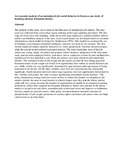| dc.description.abstract | The purpose of this study was to analyze the behaviour
of unemployed job seekers. The data used was collected from
a peri-urban region utilizing multi-stage sampling procedure.
The first stage involved snow ball sampling, while
the second stage employed a random numbers table to enable
a probabilistic analysis of the data.
A job search model was developed based on an earlier
simultaneous search model developed by Stephenson (1976).
This model was estimated by use of Ordinary Least Squares
estimation technique.
Analysis was done in two sections. The first section
employed simple algebraic measures (i.e. ratios, proportions,
fractions and percentages) while the second section
utilized regression analysis.
The study found that: most of the job seekers are
young, single, secondary and primary school dropouts,
indigenous of the area under study, had not been employed
before, used direct visit to employers to look for jobs and
had been unemployed for less than half a year. Male job
seekers were more educated and trained than females. The
estimated tenure of job sought and the search cost had the
best fitting equations. Estimated tenure of job sought was
found to be significantly dete~mined by search duration and
sex,-while, search cost was significantly determined by
quit decision and expectations of being reinstated to an
old job. All the other variables used were not conventioniii
ally statistically significant. Search duration and reservation
wage equations were not significantly determined by
the v~riables used jointly but value of assets significantly determined search duration. '
The policy implications arising from our results on
how to reduce the number of unemployed job seekers include:
the need to keep females in schools longer since they join
the labour market while still very young; increase the
number of opportunities in middle-level manpower training
institutions; reduce inter-regional development imbalances;
induce new entrants in the labour market to accept lower
job offers; streamline jobs in informal sector and improve
co-ordination between employers and job seekers. other
policy recommendations included reduction of planned tenure
of job sought, protection of workers rights and induce job
seekers who own high valued assets to develop them. | en |

